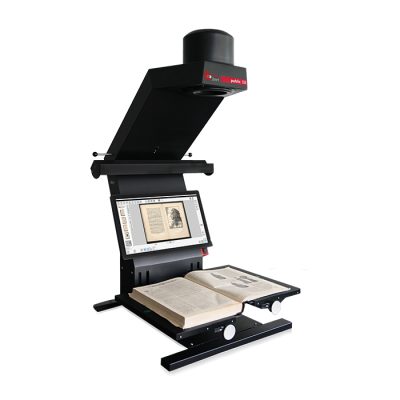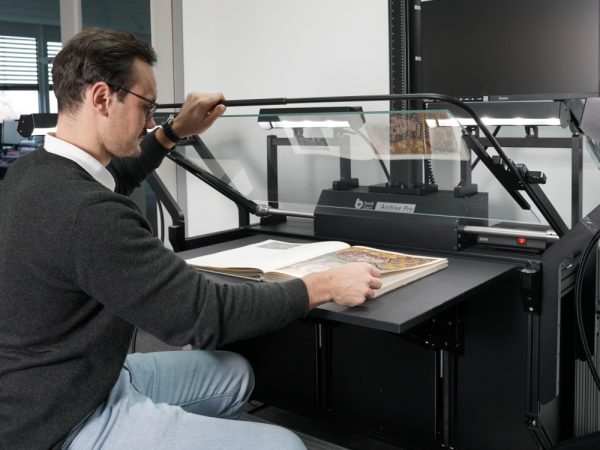How to choose the right book scanner for my collection?
Choosing the right scanner for library, archive or museum collections might be challenging. Professional equipment for creating digital reproductions is a sizeable investment, as it should meet high-quality requirements. Using the wrong tools can mean having to digitize your collections again in the future. Therefore, we prepared a short guide for those looking for the right scanning equipment.
1. Reading room or digitization workshop?
Book scanners are primarily divided into self-service devices for readers and those for mass digitization, operated by qualified institutional staff.
Self-service scanners have a built-in computer with a secure Windows IoT system and a touchscreen monitor. They allow library, archive, or museum visitors to quickly make a digital copy of selected pages or entire books and save the files to a USB drive. Scans can also be sent to a private email, for example, in a searchable PDF format. Such scanners successfully replace traditional copiers, making working with text much more effortless.
Scanners designed for mass digitization use external workstations with high-capacity disks and monitors to inspect digital reproductions in TIFF format. Scans can be supplemented with metadata, saved to a network location in additional presentation formats (such as JPEG), or uploaded to a digital repository.

The book2net Profi A2 is also available in a dual-use configuration. It can be used in both the digitization lab and the reading room.
2. Analyze the collection
• Start with the formats. Single pages, regular books or large maps?
Determining the right scanning format is crucial, so take the time to carefully examine the objects to be digitized to avoid a misguided investment.
For homogeneous library collections, the choice is simple: you only need to determine the maximum size of the largest object when unfolded and include a small margin to be sure to capture all the information. However, suppose the collection you plan to digitize consists of diverse objects (e.g., photographs and books up to A3 and A1). In that case, you need to determine the percentage distribution of formats to avoid an error. In a situation where a large format represents a proxy of the collection, there are better ideas than investing in the largest cradle scanner, such as Hornet A0. Consider efficiency. Instead, It would be best to consider buying a smaller device that will “handle” most of your collection. In such case, it is best to equip the digitalization studio with a reprographic set, i.e., a simplified design with a reproduction column with great possibilities for expansion in the future. In this way, the work can be done on two workstations for the price of one large-format scanner.
When examining the physical size of books, remember to check the maximum width of the spine. This information will allow you to adjust the appropriate working range of the cradle. Cheaper designs without book cradles (for example, book2net Repro) will suffice for scanning single-page documents or thin booklets.
• Check the state of preservation.
Older, fragile objects, mainly ornamented manuscripts, require special conservation treatment. Considering the recommendations of conservators, all book2net scanners can scan without a pressure glass by raising or removing it, and the high depth of field allows all details to be recorded.
Importantly, models with V-shaped cradles (Cobra, Dragon, Lizard) allow scanning books without fully opening them, further protecting the stitching.
One scanner to digitize them all
Your collection includes books, typescripts, maps, registers, binders, and transparent materials like glass negatives? Digitizing these materials requires special procedures: changing the scanning format, cropping mode, removing the pressure glass, or using a backlight. A solution we created for diverse archival and museum collections is the latest model in our lineup: book2net Archive Pro. It offers unprecedented flexibility, allowing predefined settings to change automatically depending on the characteristics of the object.

3. Define quality criteria.
The goal of scanning is to preserve various historical objects and make them available to audiences worldwide. For this reason, in the mass digitization of cultural heritage, the accurate reproduction of the original is the key to success. To be sure that you digitize your collection appropriately, be sure to check the guidelines in place at your institution. If there are none, the recommendations of the National Library, the National Archives, the National Museums or international guidelines such as FADGI, Metamorfoze or the ISO 19264 standard may be a reference.
It is a good idea to purchase a high-resolution scanner. However, you should remember that the solution and its resolution must be adequate, meaning there should be an actual translation into the amount of detail that can be recorded. For example, for efficient optical character recognition (OCR) for a font size of 8-10 points, 300 ppi is perfectly sufficient. At the same time, the recommended resolution for special collections, according to FADGI guidelines, is 400 ppi. In addition to optical resolution, color reproduction (Delta E parameter), geometry or linearity also affect scan quality. We strongly recommend reading the 3rd edition of FADGI, published in 2023 – providing fantastic explanation of the different quality factors, workflow and metadata.
Even the basic book2net models for mass digitization (Kiosk) are created, taking into account the current guidelines. Advanced designs (Ultra) match the most sophisticated quality requirements, such as the very exact reproduction scale, even for objects with thick and corrugated pages.
Institutions planning their first digitization project should secure sufficiently large storage space. For example, a single scan of a full A2 format at 400 ppi in a TIFF file without compression will take more than 200 MB. This means that one terabyte (1 TB) is enough to store only 5,000 such scans, and additional space for security copies should be considered. Fortunately, in recent years the cost of storing data has decreased significantly, and central institutions are offering their IT infrastructure.
4. The importance of efficiency.
Scanning time is one of the basic parameters that allow you to determine the number of devices needed to digitize a specific collection in the specified time.
book2net has pioneered the use of matrix sensors. As a result, it offers the fastest scanners in the world. A full scan takes only about 3 seconds regardless of the object’s format, including saving the file to disk. For dual-matrix models, the time is about 5 seconds due to the double amount of data. This means an output of more than 1,000 pages per hour – not including the time needed to change pages and prepare the object for scanning. In practice, experienced scanner operators can complete up to several thousand scans in a single shift.
5. The Total Cost of Ownership (TCO) and service.
Even minor equipment failures can have severe consequences in a digitization project as they cause delays in work. With book2net scanners, you don’t have to worry about downtime. The absence of moving scan head parts and using only industrial-grade components translates directly into high reliability and extended scanner life.
In addition, during the training, we teach you the calibration procedure so that performing basic operations to correct deviations from a certain standard does not involve waiting for a technician’s visit. Therefore, the total cost of purchasing equipment in digitization projects should consider the entire life cycle of the scanner, including post-warranty service. book2net does not make the warranty dependent on the number of scans made.
Summary
Should you plan to purchase a scanner for readers and visitors, choose a self-service model with an integrated computer and monitor.
When choosing a cradle scanner for a digitization workshop, start with an analysis of the collection and, based on that, determine the maximum scanning area. Additionally, consider scanners that offer an adjustable scan head position for diverse archival and museum collections – they provide greater flexibility and allow you to maximize resolution, starting from the macro format. V-shape scanners will be perfect for bounded materials, but classic cradle or flat table will be a better solution for single pages.
If in doubt, contact us. We provide free consultations to help you choose the most appropriate solution for your collection.
